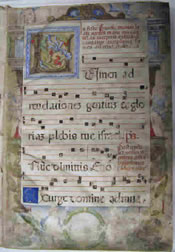| B i o g r a p h y |
 Gregorian chant
is the central tradition of Western plainchant, a form of monophonic,
unaccompanied sacred song of the Roman Catholic Church. Gregorian chant
developed mainly in the Frankish lands of western and central Europe
during the 9th and 10th centuries, with later additions and redactions.
Although popular legend credits Pope Gregory the Great with inventing
Gregorian chant, scholars believe that it arose from a later
Carolingian synthesis of Roman and Gallican chant.
Gregorian chant
is the central tradition of Western plainchant, a form of monophonic,
unaccompanied sacred song of the Roman Catholic Church. Gregorian chant
developed mainly in the Frankish lands of western and central Europe
during the 9th and 10th centuries, with later additions and redactions.
Although popular legend credits Pope Gregory the Great with inventing
Gregorian chant, scholars believe that it arose from a later
Carolingian synthesis of Roman and Gallican chant.
Gregorian chants are organized into eight scalar modes. Typical
melodic features include characteristic incipits and cadences, the use
of reciting tones around which the other notes of the melody revolve,
and a vocabulary of musical motifs woven together through a process
called centonization to create families of related chants. Instead of
octave scales, six-note patterns called hexachords came to define the
modes. These patterns use elements of the modern diatonic scale as well
as what would now be called B flat. Gregorian melodies are transcribed
using neumes, an early form of musical notation from which the modern
five-line staff developed during the 16th century. Gregorian chant
played a fundamental role in the development of polyphony.
Gregorian chant was traditionally sung by choirs of men and boys in churches, or by women and men of religious orders in their chapels. It is the music of the Roman Rite, performed in the Mass and the monastic Office. Gregorian chant supplanted or marginalized the other indigenous plainchant traditions of the Christian West to become the official music of the Roman Catholic liturgy. Although Gregorian chant is no longer obligatory, the Roman Catholic Church still officially considers it the music most suitable for worship. During the 20th century, Gregorian chant underwent a musicological and popular resurgence.
The renewed interest in early music in the late 19th century left its mark on 20th-century music. Gregorian influences in classical music include the choral setting of four chants in "Quatre motets sur des thèmes Grégoriens" by Maurice Duruflé, the carols of Peter Maxwell Davies, and the choral work of Arvo Pärt. Gregorian chant has been incorporated into other genres, such as Enigma's "Sadeness (Part I)", the chant interpretation of pop and rock by the German band Gregorian, the techno project E Nomine, and the work of black metal band Deathspell Omega. Norwegian black metal bands utilize Gregorian-style chants for clean vocal approach, featuring singers such as Garm or ICS Vortex of Borknagar and Dimmu Borgir, and Ihsahn of the band Emperor. The modal melodies of chant provide unusual sounds to ears attuned to modern scales.Gregorian chant as plainchant experienced a popular resurgence during the New Age music and world music movements of the 1980s and '90s. The iconic album was Chant, recorded by the Benedictine Monks of Santo Domingo de Silos, which was marketed as music to inspire timeless calm and serenity. It became conventional wisdom that listening to Gregorian chant increased the production of beta waves in the brain, reinforcing the popular reputation of Gregorian chant as tranquilizing music.
Gregorian chant has often been parodied for its supposed monotony, both before and after the release of Chant. Famous references include the flagellant monks in Monty Python and the Holy Grail intoning "Pie Jesu Domine" and the karaoke machine of public domain music featuring "The Languid and Bittersweet 'Gregorian Chant No. 5'" in the Mystery Science Theatre 3000 episode Pod People.
From Wikipedia, the free encyclopedia